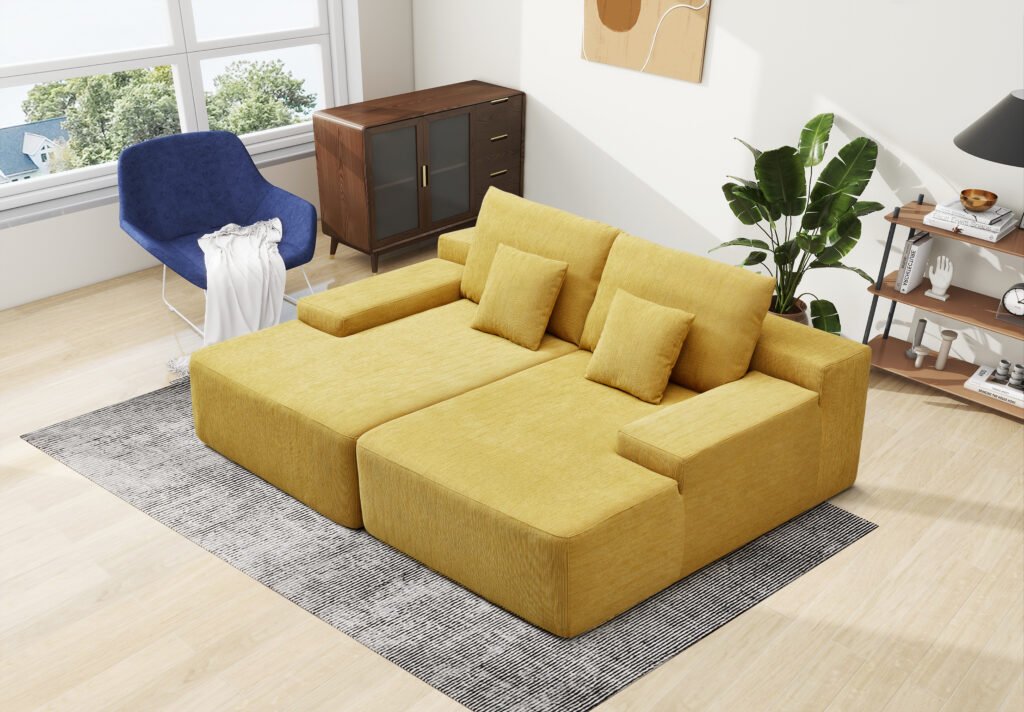In the furniture industry, especially for B2B companies involved in manufacturing, retail, and hospitality, safety is a paramount concern when selecting sofas for environments frequented by children and pets. This article compares compress sofas and traditional sofas from a safety perspective, highlighting key factors that businesses should consider when making procurement or product development decisions.
Understanding Compress Sofas and Traditional Sofas
Compress sofas are designed with innovative materials such as pressure-resistant polymer compression sponges and are vacuum-packed for efficient shipping. They typically use advanced foam and fabric technologies to provide comfort and durability.
Traditional sofas generally consist of conventional spring systems, foam cushions, and upholstery fabrics, often shipped fully assembled or partially assembled.


Key Safety Considerations for Kids and Pets
1. Material Safety and Chemical Exposure
- Compress Sofas: Many compress sofas use high-quality, non-toxic foams and fabrics that are free from harmful chemicals like formaldehyde and flame retardants, which are crucial for children’s and pets’ health. Advanced materials used in compress sofas tend to have certifications for low VOC (Volatile Organic Compounds) emissions, reducing the risk of respiratory irritation or allergic reactions.
- Traditional Sofas: Older or lower-cost traditional sofas may contain chemical treatments or flame retardants that can pose health risks, especially for sensitive groups like children and pets. Some traditional upholstery materials may off-gas harmful substances over time.
For B2B buyers, prioritizing compress sofas with certified non-toxic materials can enhance workplace or hospitality safety standards and meet regulatory compliance1.
2. Structural Safety and Stability
- Compress Sofas: Due to their modular and compressed packaging design, these sofas often feature reinforced frames and tightly integrated cushions that reduce the risk of loose parts or sharp edges, which can be hazardous to kids and pets. The compact design also minimizes gaps where small children or pets could get trapped.
- Traditional Sofas: Traditional sofas with removable cushions and exposed springs can pose risks such as pinching or ingestion hazards if cushions are displaced. Pets, especially dogs and cats, may chew on exposed wooden frames or springs, leading to injury or damage.
B2B clients in childcare facilities, pet-friendly hotels, or family-oriented businesses may find compress sofas safer due to their integrated design and reduced risk of injury.
3. Fabric Durability and Cleanability
- Compress Sofas: Typically use durable, stain-resistant fabrics that are easier to clean and maintain. Many compress sofa covers are designed to be removable and washable, which is important for hygiene in environments with children and pets.
- Traditional Sofas: Often use fabrics that absorb stains and odors more readily, and cleaning can be more challenging. This can lead to bacterial buildup, which is a health concern in high-traffic or family environments.


For B2B sectors like hospitality or healthcare, compress sofas offer operational advantages by reducing cleaning time and maintaining sanitary conditions.
4. Resistance to Wear and Tear from Kids and Pets
- Compress Sofas: The advanced foam and fabric technologies used in compress sofas provide better resistance to deformation and damage from jumping, scratching, or chewing. This durability extends the sofa’s lifespan, reducing replacement costs for businesses.
- Traditional Sofas: More prone to sagging, tearing, or frame damage under heavy use by children and pets, leading to higher maintenance and replacement expenses.
Additional B2B Considerations
- Shipping and Installation: Compress sofas are vacuum-packed and easier to transport and install, minimizing workplace hazards during delivery and setup compared to bulky traditional sofas.
- Sustainability: Compress sofas often incorporate recyclable and eco-friendly materials, aligning with corporate social responsibility goals and appealing to environmentally conscious clients.
- Customization and Compliance: B2B buyers can request custom fabrics or safety features (e.g., fire-retardant but non-toxic materials) in compress sofas to meet specific safety regulations or brand requirements.


Summary Comparison Table
| Safety Factor | Compress Sofas | Traditional Sofas |
|---|---|---|
| Material Toxicity | Low VOC, non-toxic certified materials | Potential chemical treatments, off-gassing |
| Structural Safety | Reinforced frames, integrated cushions | Removable cushions, exposed springs |
| Fabric Cleanability | Stain-resistant, washable covers | Absorbent fabrics, harder to clean |
| Durability Against Damage | High resistance to wear from kids/pets | More prone to sagging and damage |
| Shipping & Installation | Compact, safe handling | Bulky, higher risk during transport |
| Sustainability | Often eco-friendly and recyclable | Varies, often less sustainable |
Conclusion
For B2B companies selecting sofas for environments with children and pets—such as daycare centers, family hotels, or pet-friendly offices—compress sofas generally offer superior safety advantages over traditional sofas. Their use of non-toxic materials, integrated design reducing injury risk, durable and cleanable fabrics, and sustainable construction make them a safer and more cost-effective choice in the long term.
By incorporating compress sofas into product lines or procurement strategies, businesses can enhance safety compliance, reduce maintenance costs, and appeal to eco-conscious customers, creating a competitive advantage in the furniture market.